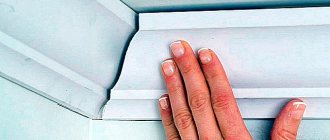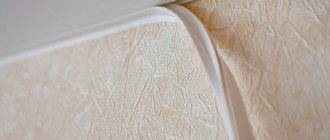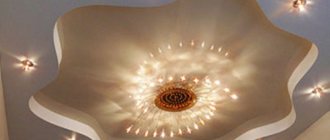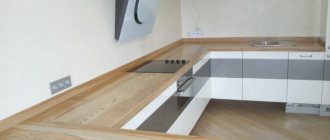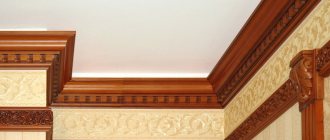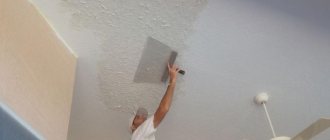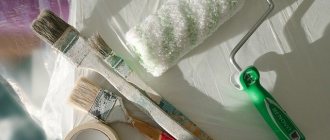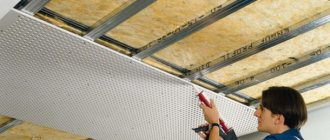So, the new glossy ceiling sparkles in the rays of the setting sun. The installers have left, the garbage has been removed... But what is this gap between the ceiling surface and the wall? Oh yes, after wallpapering, masking tape for suspended ceilings should be inserted there. Should I stick with it or prefer a ceiling plinth?
Let's find out more about this inconspicuous-looking plastic profile.
How can I replace ceiling plinth?
Instead of fillets, other methods of masking joints are used. Unlike baseboards, they are suitable for small spaces, as they do not visually make the room smaller.
Ceiling masking tape
Read also: How to make a third person view. »
This insert can be ordered together with a stretch ceiling. The plug is suitable for curved walls, corners and dividing profiles (between different panels).
The flexible decorative insert is selected to match the main material.
They are produced in the same colors and textures as the surface of the canvas. As a result, the joint is almost invisible. The tape is inserted into the gap without the use of glue; if necessary, it can be easily removed and attached back. In the corners it fits at 45 degrees without additional elements. Cut with sharp nippers or a knife. Masking tape prices
This is the most popular way to hide the installation gap. The advantages include ease and speed of installation, the disadvantages are that the rooms in some styles look unfinished.
Is it necessary?
The answer to the question of whether a plinth is needed depends on the type of ceiling installed.
If we are talking about PVC film, then yes, a baguette is necessary. Because such fabrics are stretched in three ways: harpoon, wedge and glazing bead.
In all cases, a gap of about 0.5 cm is formed along the perimeter between the wall and the film. This looks unaesthetic, so it is covered with a plinth or a special decorative insert.
If we are talking about fabric stretch ceilings, then they are inserted into a special clothespin profile. In this case, there are no gaps left, and there is no urgent need for a plinth. If desired, you can not install it.
Material calculation and tools
To calculate the required amount of material, you need to calculate the perimeter of the room. This applies, first of all, to rooms with complex geometry. The resulting figure should be divided by the length of the bar of the selected model, and as a result we will get the required quantity.
It is recommended to purchase an additional bar to avoid the need for additional purchases if unforeseen difficulties arise during the work.
Trimming corners of adjacent fillets
Tools you will need:
- construction knife, hacksaw, sandpaper;
- miter box. This is a special tool, as in the photo, that allows you to easily and accurately file corners. It is important to check the direction of the cut;
- ruler, tape measure, protractor (if the corners are not perfectly straight);
- a simple pencil for marking;
- rubber and metal spatulas.
Miter box for trimming skirting boards
Plug for level profiles
Here you need to decide which profile will be used.
There are aluminum profiles for R-type plugs. Almost any separating pad will fit there.
There are also level profiles for LED strip. Such designs come with their own special translucent matte silicone plug.
How to install a ceiling plinth on a suspended ceiling
Finishing the ceiling
As a rule, the ceiling plinth is the logical conclusion of the finishing work. It highlights the corners of the room and makes them more attractive. However, if it is quite simple to glue a plinth onto a regular ceiling, for example, made of plasterboard, then for a stretch ceiling the situation is different. Is it possible to install a ceiling plinth in this case? Yes! To do this, you will need to observe some nuances, which will be discussed in this article.
Read also: Projects of verandas attached to the house
Recommendations from professionals for installing fillets
Consider these tips:
- level the walls;
- if necessary, call specialists for installation;
- do not attach the product to the ceiling;
- While working, cover the canvas with film;
- take preliminary measurements.
It is these discreet details that often serve as the finishing touch, emphasizing a particular style of furnishings.
Masking tape for stretch ceilings
Masking tape, or a plug for suspended ceilings, is often supplied by the manufacturer as a kit, like other accessories for suspended ceilings. It must be attached directly to the groove of the profile. It prevents the formation of dust and dirt that would inevitably accumulate in an open gap.
Helpful advice! The advantage of masking tape for stretch ceilings is the possibility of its repeated use. If there is a need to dismantle the ceiling (flooding, wiring repairs, etc.), the tape can be easily removed and just as easily reattached.
Masking tape can be matched to the color of the stretch ceiling surface
Masking tape is used for decorating multi-level ceilings, as evidenced by photos of such examples, as well as when splicing canvases. It is advisable to use a decorative insert for suspended ceilings on flat areas, otherwise it will only emphasize all the unevenness.
Main settings
First of all, you should decide in which room the finishing will be done, since this determines which plinth to glue. For bathroom suspended ceilings, it is better to choose moisture-resistant materials from which dirt can be easily removed. In the bedroom and living room, fulfilling this condition is not so important, but it is important that no toxic fumes emanate from the baseboard. Each product must be accompanied by a safety certificate, which you should read.
Depending on the size and type of room, skirting boards are selected according to the following characteristics:
- Width. For rooms with a ceiling height of 2.5 m or less, the optimal width of the structure is up to 4 cm. For ceilings from 2.5 to 3 m, a plinth 5-10 cm wide is required. If the height of the room walls exceeds three meters, you can choose fillets wider than 10 cm.
- Form. If the finishing involves the presence of many complex details, classic skirting boards will look more appropriate. To create a bright accent that stands out against the background of the overall interior, you can use curly elements.
- Color. The shade is selected depending on the color scheme of the room. If there is a need to visually make the room more spacious, it is recommended to choose canvas and skirting boards of the same color. In order to create the effect of a high ceiling, you should match the design to the color of the walls.
Ceiling plinth for stretch ceiling: types, advantages
Before you buy a ceiling plinth for a stretch ceiling, you should understand the following issues - types and features of products, as well as their characteristics.
The following types of fillets are popular today:
1. Made from polystyrene foam. This option is considered the simplest and most affordable. This type of plinth is easy to use, lightweight, and affordable. But there are also disadvantages - fragility, lack of plasticity, difficulty in choosing a suitable glue (not all compositions are capable of properly attaching foam fillets to the surface). There are cases when glue literally corrodes the product (for example, Moment).
2. Made of polyurethane. This version of the plinth for the ceiling is good for its elasticity and strength. The product can be used when finishing “crooked” walls and other difficult areas. On the other hand, such a product is quite heavy, so if the adhesive is chosen incorrectly, cracks may appear. Advantages: flexibility, wide range (in design and width), modern appearance, durability, ease of installation, possibility of use on various surfaces and ceilings of various shapes. Cons: significant weight, high price.
3. Made of plastic. In recent years, plastic has become especially popular. And indeed. This material is durable, lightweight and high density. The product can be glued using a wide variety of compounds. At the same time, the choice of options is really wide - you can choose a plastic product to match stucco or wood. On the other hand, if the room has curved walls or ceilings, then plastic fillets are not the best choice, because they will not only not eliminate the imperfections, but will also emphasize them. Advantages - strength, light weight, no requirements for an adhesive composition, a wide choice of options (stucco, wood or stone).
Disadvantages: cannot be used on uneven walls.
How to choose and install an insert (plinth) for suspended ceilings?
4. Made of wood. Wooden plinths for suspended ceilings are a rare occurrence, but they are in considerable demand among connoisseurs of all things natural. Such products can be made from various types of wood. Moreover, their cost will be higher than that of the analogues discussed above. The most popular are products made from veneer or pine, which are distinguished by their relatively low price, unpretentiousness, durability and original appearance. If you cover the surface of the fillet with special compounds, the product will be reliably protected from UV rays and various bugs. Advantages: environmental friendliness, high installation speed, solid appearance. Disadvantages - high price, lack of plasticity, heavy weight, difficulty in choosing material for fixation.
5. Plaster stucco. People who want to stand out and make their room design excellent choose plaster products. Thanks to the capabilities of this material, it is possible to create almost any shape. It all depends on the professionalism of the master. Gypsum fillets have recently been increasingly used by professional designers in interior design. Advantages: high quality, environmental friendliness, original appearance, long life.
Disadvantages - high cost, significant weight, fragility, difficulty of installation (high risk of damage to the product).
So, when choosing a product, you should pay attention to the following criteria:
1. Weight. The lighter the fillets, the more securely they will be fixed under the ceiling and the lower the risk of cracks appearing.
2. Width (we are talking about the surface that abuts the wall). Is it possible to glue plinth to a suspended ceiling? - Definitely not. If you take this step, the PVC film may become deformed. However, there is no guarantee that the product will not be damaged by the action of the composition. That's why when choosing a plinth you should pay attention to the width of the surface that comes into contact with the wall. The larger it is, the more securely the product is fixed. In addition, it is worth considering another width (from the wall to the center of the room). It depends on it whether the decorative product can hide the defects in the room.
3. Flexibility. This indicator is especially important when it comes to walls that have uneven surfaces.
4. Color and texture. Here the choice is made taking into account personal preferences, the design features of the room and the color of the existing finish.
Bottom line
Modern ceiling technologies do not stand still, and ceiling fastening systems have long appeared that do not require decorative plugs. This is a shadow profile, and the Stock system, and Lumpher came up with something of his own. But all these new technologies are noticeably more expensive, and therefore the classic elastic band will be in demand for a very long time.
Use only good tape that is easy to install, do not save these 1-2 rubles per meter. Use special tools for installation: various inserters, rollers, corner scissors for PVC. Measure the room using a laser tape measure.
Share with friends:
Rubber plinth for stretch ceiling
One of the most popular is the option using polyurethane (rubber) ceiling plinth.
The design feature is in the chemical composition, part of which is rubber.
Thanks to this, the cornice is characterized by increased flexibility and strength.
In addition, with the help of a rubber plinth it is possible to decorate even crooked (broken, deformed or curved) walls.
Other products do not have such qualities.
Rubber plinth is used for finishing the following premises:
- bathroom;
- swimming pool;
- bathroom;
- saunas and so on.
The advantages of the material are moisture-resistant qualities, resistance to temperature changes, flexibility and pliability, ease of installation. This type of decor is suitable for finishing PVC film.
During the installation process, glue made on a polymer-alcohol basis is used. It is recommended to install the rubber plinth before the final finishing (wallpapering, painting).
732
Selection of design design
Ceiling plinths are the finishing touch that connects the furnishings together. Thanks to the variety of models, you can choose the molding that best suits a certain type of interior:
- The optimal complement to the classic matte canvas will be baguettes with elegant stucco molding or relief curls. It is acceptable to use plain parts, as well as options that imitate bronze or gold plated. Wooden products are suitable for strong walls. Such moldings are appropriate for any shade of fabric; they look solid and expensive.
- In interiors chosen in a minimalist style, you can use simplified designs with a smooth surface.
- For country style, wood is the main raw material. Depending on preference, the surface of the plank can be sanded, varnished or rough.
- The luxury of Baroque is emphasized by polyurethane skirting boards, decorated with three-dimensional ornaments or stucco molding. A carved wooden structure would also work.
- Bleached polyurethane or wooden moldings can convey the atmosphere of Provence and Scandinavia.
- For a strict English style, cornices made of varnished mahogany are preferable. If the product is decorated with golden inserts and carvings, the room will resemble a guest room of the late 19th century.
Selection rules
If it is enough to create a neat frame and only mark the border, use special PVC masking tapes.
For designer cornices, foam skirting boards with a complex profile are used. Often, in order to make a wide plinth with hidden lighting and not worry about the reliability of its fastening, they buy not one solid massive profile, but assemble it from separate smaller elements. So, in the lower part you can glue a slatted figured baguette, which will be firmly held on the surface, and the upper part of the inlaid cornice can be glued from a plinth-type profile.
Important! When arranging hidden lighting, the profile of the canvas border should not be too narrow.
The height of the cornice must be correlated with the size of the entire room.
Variety of colors
The material of the stretch fabric looks most advantageous in a contrasting frame. It is not necessary for the plinth to be sharply different in color from the canvas, but it is advisable to indicate the baguette with at least a different shade.
